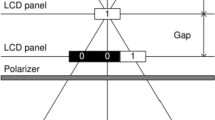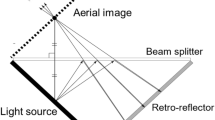Abstract
We have realized a multifunctional aerial display. An aerial image of a polarization-processing display is formed through aerial imaging by retro-reflection. By changing the polarization modulation patterns, we can switch between a three-layered display and a secure display.
Similar content being viewed by others
Avoid common mistakes on your manuscript.
1 Introduction
Aerial display enables us to handle visual information in the air. Aerial display forms a transparent screen that is floating in the air. An aerial image can be formed using a dihedral corner reflector array (DCRA) [1], a crossed slit mirrors array called an AI plate [2], and retro-reflectors. We have proposed aerial imaging by retro-reflection (AIRR) [3, 4]. The DCRA and AI plate form aerial images with double-reflected light. Single-reflected light in the DCRA and AI plate is stray light and forms pseudoimages that become visible when viewed from the left and the right. However, AIRR has a wide viewing angle of well over 120° [4] and does not show pseudoimages as in the case of DCRA and AI plate. Furthermore, the cost of the optics in AIRR is much lower than those for DCRA and AI plate. Thus, AIRR is suitable for fabricating the prototype aerial display used for feasibility studies, the aerial large screen, and aerial signage with a wide viewing angle.
In this paper, we propose a multifunctional aerial display. In order to show information on depth, a multilayered display will be useful. Furthermore, in order to show secret information such as personal identification codes, a secure display that prevents peeping at the screen is required [5, 6]. In order to switch these functions, we have realized a polarization-processing display [7]. The aim of this study is to utilize the polarization-processing display as the aerial display. An aerial image of the polarization display is formed by AIRR, because AIRR covers such a wide viewing angle that the limitation of the viewing zone is considered to be due to the optical coding. Furthermore, a multifunctional aerial display is demonstrated.
2 Polarization-processing display
In a conventional LCD display, an LCD panel is placed between polarizing films. In our proposed display, three LCD panels are placed between polarizing films with a certain gap. The structure of our developed polarization-processing display is shown in Fig. 1. Three LCD panels are stacked with a certain gap (1 cm). The gaps generate parallax and directivity of the polarization-processing results.
TN-LCD panels are used for the polarization-processing display. In the state where voltage is not applied to the liquid–crystal panel, the polarization angle rotates 90° along with the molecule of liquid crystals. In contrast, under the state where a sufficient voltage is applied, polarization is not modulated in an ideal condition. In the proposed structure, the polarization angle is modulated three times after passing through the three LCD layers, as shown in Fig. 2. Polarization is rotated by 90° at maximum by one LCD panel. In total, polarization can be rotated by 270° at maximum by the three LCD panels, as shown in Fig. 3.
In this paper, we deal with binary images. Note that black and white are denoted by pixel values of 0 and 1, respectively, in this paper. When binary images are displayed in the three LCD panels, the XOR operation of pixel values is performed by the polarization modulation using the three LCD panels. As shown in Fig. 4, when pixel values of the rear, middle, and front LCD panels are set to \(r_{k}\), \(m_{k}\), and \(f_{k}\), respectively, the reproduced pixel value \(E_{k}\) is expressed by:
where the displayed images are binary, that is,
Figure 5 shows an example of polarization processing. The output light distribution depends on the three polarization modulations. Black pixels in the displayed image correspond to the absence of modulation of the polarization angle.
2.1 Three-layered display
In a simple demonstration of the three-layered display, different images in the three LCD panels are shown separately. The displayed images for the front, middle, and rear LCD panels are shown in Fig. 6. The result of viewing from different directions show a parallax shift between the layered images, as shown in Fig. 7.
2.2 Secure display
In order to limit the viewing zone, the polarization encryption [8] scheme is utilized for the polarization-processing display. When the display is observed from an anterior view, the reproduced pixel value \(E_{k}\) is expressed by Eq. (1). Because there is a gap between the LCD layers, the polarization-processing display represents different pixel values depending on the viewing direction. When the display is observed from the right-hand side, for instance, as shown in Fig. 8, a pixel value \(R_{k}\) is given by the polarization-processing result of the (k + 1)-th pixel in the front of LCD panel, k-th pixel in the middle LCD, panel and the (k − 1)-th pixel in the rear LCD panel. Represented pixel values at the central viewing position, denoted by \(C_{k}\), depend on the overlapped pixel values. Thus, these represented pixel values are obtained by
As shown in Eqs. (3) and (4), the reproduced pixel varies between the viewing position in front of the display and a position of peeking at the display. As shown in Eqs. (3) and (4), the reproduced pixel value differs between the central viewing position and the peeking position.
The front and rear images are used as keys in polarization encryption. The encrypted image, which is the image displayed on the middle LCD panel in this case, is calculated by solving Eq. (1) to represent the secret image as \(E_{k}\). Figure 9 is an example of the displayed images that represent a secret image after the polarization processing. Images viewed from different directions are shown in Fig. 10. The secret image “Center” is visible at the limited position. Images viewed from the left and the right are distorted.
2.3 Algorithm of pixel values setting in secure display
The reproduced pixel value \(C_{k}\) is expressed by Eq. (4). Here, the viewed secret image is set to “Center”. Thus, the reproduced pixel value \(C_{k}\) is set. Pixel values \(r_{k}\) and \(f_{k}\) are set by the displayed images in the front and rear LCD panel as shown in Fig. 5. Rearrange Eq. (4) for the pixel value \(m_{k}\) of the image displayed at the middle LCD panel.
Here, \(r_{k}\), \(f_{k}\) and \(C_{k}\) are set by the displayed images and the secret image. Thus, the pixel value \(m_{k}\) can be determined using Eq. (5). On the other hand, the images displayed in the front LCD and rear LCD panels can be chosen arbitrarily because \(m_{k}\) usually has a real solution in Eq. (5).
3 Aerial imaging by retro-reflection (AIRR)
The basic setup for AIRR [4, 5] is shown in Fig. 11. Light from the source display is reflected by a beam splitter and impinges on a retro-reflector. The retro-reflected light reversely travels the optical paths and converges at the source display position. Some part of the retro-reflected light also converges at the plane-symmetrical position of the source display regarding the beam splitter. Thus, the aerial image of the source display is formed in the air. AIRR features a wide viewing angle with cost-effective commercially available optical components.
4 Multifunctional aerial display
By using the polarization-processing display as the source display, we realized a multi-functional aerial display with AIRR.
As shown in Fig. 12, our realized aerial display shows an aerial image that is tilted by 45° from the beam splitter. The polarization-processing display composed of three-layered LCD panels is used for the source display in Fig. 12. A conventional p-Si TFT LCD panel (Toshiba, LTM10C348S) is used for each layer of the polarization-processing display. The bottom LCD panel is installed without the polarizer on the surface. The middle LCD panel is installed without either the polarizer or the backlight unit. The front LCD panel is installed without the polarizer in the back and the backlight unit. A half-mirror (transmittance and reflectance is close to 0.5) is used as the beam splitter. We use a prism-type retro-reflector (Reflexite Shadow Logo).
4.1 Three-layered aerial display
The images displayed on the three LCD panels are the same as those described in Sect. 2.1, as shown in Fig. 6. The results of viewing the three-layered aerial display are shown in Fig. 13. Because the results of viewing show a parallax you can perceive three depths by binocular fusion. Note that the order in depth is reversed because AIRR forms an aerial image at the plane-symmetrical position.
4.2 Secure aerial display
A secure aerial display achieved by showing the encrypted images has been demonstrated. Aerial images of the displayed images are shown in Fig. 14. In order to show only one layer, the other two layers are set to be black, that is, there is no modulation of the polarization angle. By showing the key images in the front and rear LCD panels and the encrypted image in the middle LCD panel, as shown in Fig. 15, we have confirmed that the secret “Center” is visible from a limited position and that images viewed from outside the viewing zone are distorted.
In order to investigate the limit of the viewing zone, the prototype display was rotated. Images viewed from the different directions are shown in Fig. 16. Note that the zero-degree direction was determined as the angle where the decoded result was visible with the most clarity. Positive and negative angles correspond to viewing from the left side and the right side, respectively. We found that the viewing zone is horizontally about 8°. At 4.4°, the second “e” in “Center” was not visible. At −4.4°, “Cen” in “Center” was not visible.
5 Conclusions
By using the polarization-processing display as the source display in AIRR, we realized a multifunctional aerial display. Without any mechanical changes, a three-layered display and a secure display can be selected using the displayed images.
This paper is the first report on multilayered aerial image formation. Unlike the previously reported aerial display that was merely a remapping of a 2D image, aerial image formation at three depths provides depth cues to users. This is one of the important features for an interactive information system because depth is used for user feedback, for example, an aerial button is shown in the bottom panel when it is depressed. Furthermore, a secure aerial display ensures the security of the displayed information and will be useful for applications such as ATM and electronic medical information terminals.
This work was partially supported by JST/CREST, JST/ACCEL, and JSPS/KAKENHI.
References
Maekawa, S., Nitta, K., Matoba, O.: Transmissive optical imaging device with micromirror array. Proc. SPIE 6392, 63920E (2006)
AERIAL IMAGING, http://aerialimaging.tv/. Accessed 5 Nov 2016
Yamamoto, H., Suyama, S.: Aerial Imaging by Retro-Reflection (AIRR). SID 2013 DIGEST, 895 (2013)
Yamamoto, H., Tomiyama, Y., Suyama, S.: Floating aerial LED signage based on aerial imaging by retro-reflection (AIRR). Opt. Express 22, 26919 (2014)
Yamamoto, H., Hayasaki, Y., Nishida, N.: Securing information display by use of visual cryptography. Opt. Lett. 28, 1564 (2003)
Yamamoto, H., Hayasaki, Y., Nishida, N.: Secure information display with limited viewing zone by use of multi-color visual cryptography. Opt. Express 12, 1258 (2004)
Uchida, K., Suyama, S., Yamamoto, H.: Three-layered secure display based on polarization modulation. Proc. IDW/AD’12, VHFp-6 (2012)
Imagawa, T., Suyama, S., Yamamoto, H.: Visual cryptography using polarization-modulation films. Jpn. J. Appl. Phys. 48, 09LC02 (2009)
Author information
Authors and Affiliations
Corresponding author
Rights and permissions
About this article
Cite this article
Uchida, K., Ito, S. & Yamamoto, H. Multifunctional aerial display through use of polarization-processing display. Opt Rev 24, 72–79 (2017). https://doi.org/10.1007/s10043-016-0285-8
Received:
Accepted:
Published:
Issue Date:
DOI: https://doi.org/10.1007/s10043-016-0285-8




















